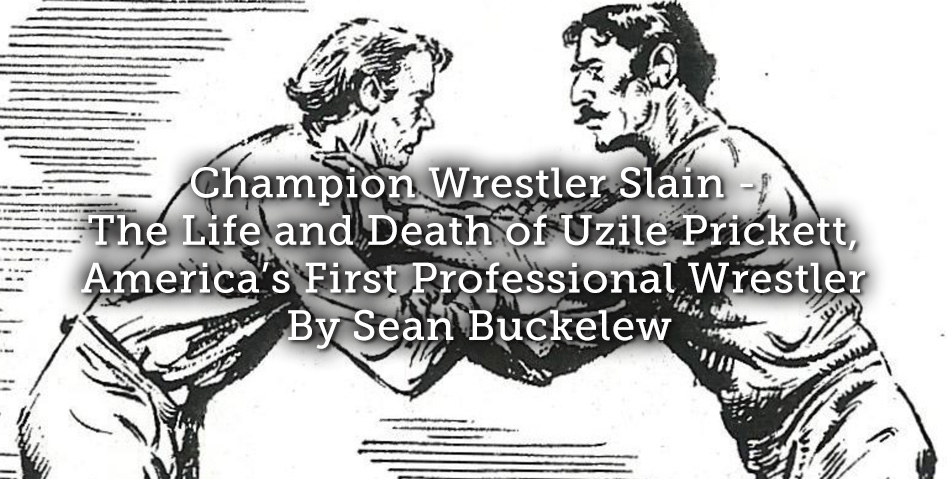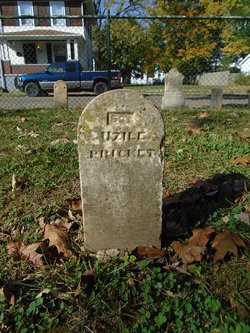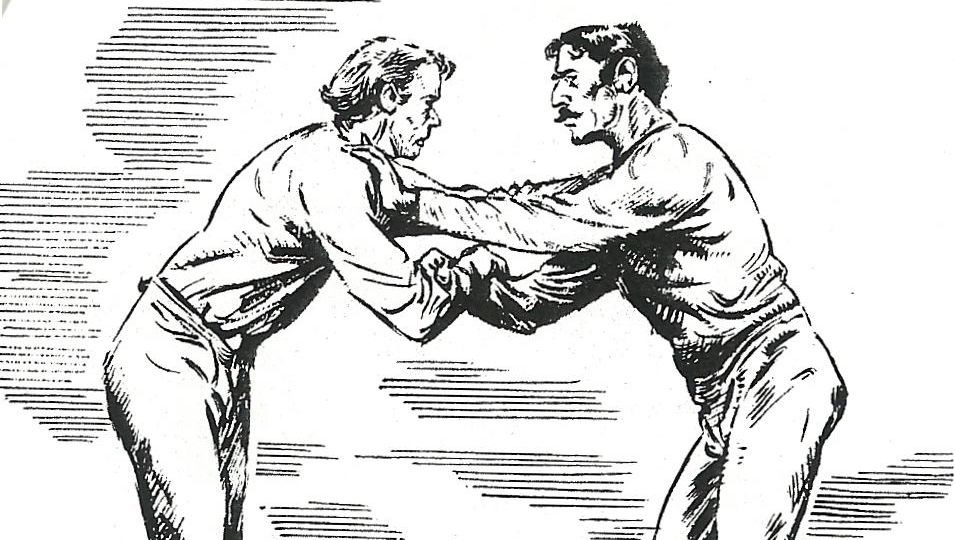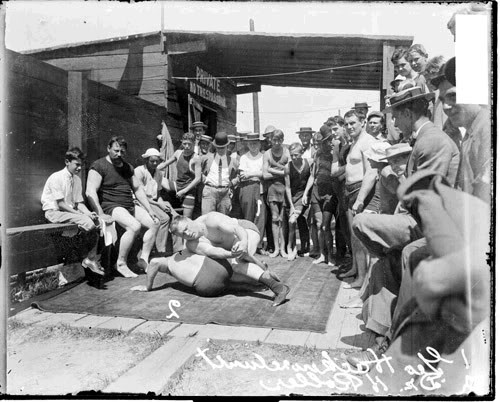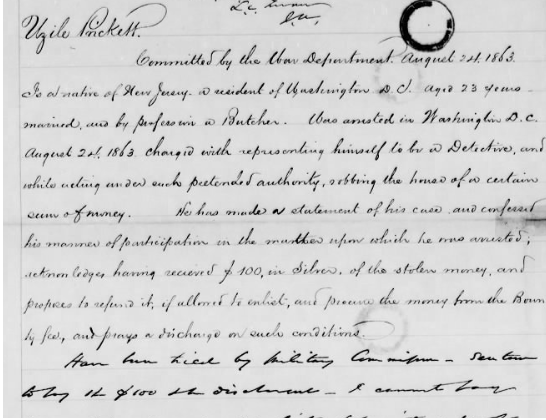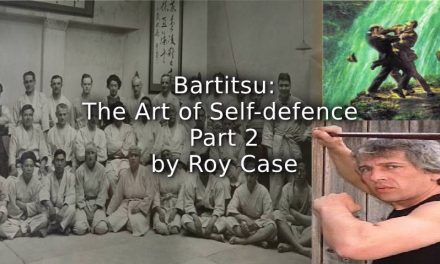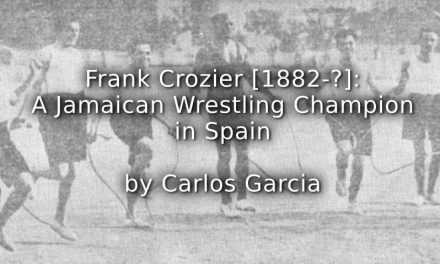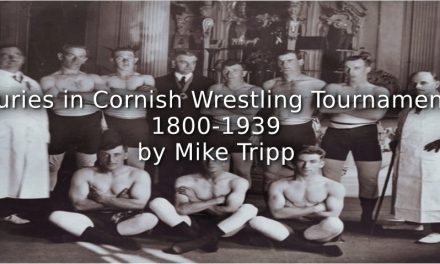On June 15, 1868 a group of disgruntled fans shot and murdered the United States wrestling champion in Hole in the Wall Saloon in the small town of Hamilton, Ohio. While police reports and newspaper articles covering the murder wrote contradictory details of who was involved, a local man named John Griffin was tried and sentenced to death for murder. Local newspapers noted his fate because he was the first man given capital punishment in the state of Ohio. As for the victim, Uzile Prickett, his life and untimely death remain little more than a peculiar footnote in the history of American wrestling. However, Prickett’s life gives clarity into the transition between legitimate amateur wrestling and fighting and the spectacular theater known today as professional wrestling.
- Uzile Pricket’s Gravestone in Greenwood Cemetery, Hamilton, Ohio
Uzile Prickett, unlike the Olympic style wrestlers who competed in legitimate bouts on much like 19th century boxing bouts, was more conman and showman than athlete. While there’s little information about the life of Prickett, what survives are accounts of high-profile wrestling bouts which ended in dramatic and disreputable fashion. Prickett hustled and swindled around the country, creating a stir in the local press to manufacture credibility. Before each bout, Prickett boasted his championship talent and considerable record boosting the betting odds on him and manipulating local culture to his advantage. Uzile’s career illustrates how amateur wrestlers transformed their legitimate sport into a new form of entertainment which set the template for the following century of professional wrestling.
- Source – https://www.gannett-cdn.com/-mm-/c8495ad6e0b4c9a82e0512dd455f7f5a12353571/c=0-74-955-614/local/-/media/2018/02/24/Burlington/B9331289485Z.1_20180224163556_000_GQ4L3NMIK.1-0.jpg
In contrast to the legitimate Olympic athletes competing in 19th century amateur wrestling Uzile Prickett was a braggart and a swindler. Because Prickett lied to boost his own reputation there is trouble sorting the truth from the fiction in his life’s story. However, a New York Times piece on a match he had with Harry Hill gives what seems to be an accurate account of his life. Uzile was born in 1840 in Cold Run, New Jersey to Hannah and Uzile Sr. At a young age Uzile showed talent for wrestling and a man by the name of Andy Hikes took him under his tutelage at the age of fifteen to travel the country as a champion wrestler.
Not much else is known about Uzile other than his significant boasts of wrestling prowess which often included him costing many betters massive amounts of money. Uzile’s most famous bout with famous barkeep, temperance advocate, and brawler Harry Hill drew the headlines in New York; However, his trail runs cold for years after. However, a few years later Uzile would once again make headlines, this time in Tennessee. In an article for Nashville Dispatch Prickett wrestles an African American named Simon Thompson. Prickett proclaims himself to be the best wrestler in the country and his presence brings about numerous spectators. However, in a shocking result, the unknown African American beat Prickett with ease. The outcome of the match made the gamblers furious. In playing himself up as an unbeatable champion and playing into the racist ideology of his fans, Prickett sets a template mimicked by wrestlers and wrestling promoters for the next century.
In this match there is a subtle story of audience manipulation which the writer of the article notices. Prickett’s knowledge of how to manipulate the audience, particularly how to antagonize the audience and turn them against him in a way that is astoundingly similar to the modern-day spectacle of storytelling that professional wrestling portrays. Prickett took nearly half an hour to warm up. Prickett stretched and relaxed every part of his body, showing off and profoundly irritating his opponent and audience. The stoic and statuesque Thompson stayed silent contrasting the braggadocios Prickett. The routine points to Prickett understanding how to build a story, harkening to elements of the tortoise and hare. Prickett played the cocky hare, showing off for a less-than-adoring crowd. Thompson played the perfect tortoise, unskilled yet steady. To anyone paying attention to the story being told the outcome was obvious, Thompson won going away. To the betting onlookers, they left in disbelief and with empty pockets. Prickett, likely betting against himself, built up expectations of his skill and prowess found storytelling as a way of increasing his audience and his pocketbook much as later professional wrestlers do to this day.
- Source ~ http://damagecontrolmma.com/wp-content/uploads/2009/08/CatchToeHold.jpg
Simon Thompson, his African American opponent, was not a wrestler. Thompson instead was a locally respected blacksmith with an exceptional reputation in the city. Interestingly, despite Thompson’s standing within the community, none of the spectators bet on him. According to the story of match, not only did Prickett enrage the onlookers with his preening before the match but also lost in pathetic fashion in the first fall. Still, the paper notes, the men in attendance held strong to their belief that an African American could not beat a white man. They still placed almost every dollar on Prickett to win. Prickett’s understanding and exploitation of racial ideology built the story. By losing to a black man, if he indeed bet on himself, he made the most money in defeat by putting in almost no effort. Concurrently, it points to how little ethnicity and pride meant to Prickett. Like modern wrestlers Prickett knew the next day he would be in a new town winning or losing to a new challenger. Thus, there was no reputation at stake for Prickett, only the reputation he made for himself in the local paper.
Local newspapers across the country picked up the story of Prickett’s final match with a man known as Tim Walker. Not surprisingly, despite being an overwhelming favorite against the unknown wrestler, Prickett lost a relatively quick bout. According to newspaper accounts Prickett lost the bout and his purse to his opponent. However, unlucky betters saw Prickett leave the match with somewhere between 800 and 900 dollars in his pocket which he reportedly did not enter the saloon with. According to many men, upset over losing bets on Prickett, he placed side bets against himself to make the large sum of money. For Prickett the contest was not victory against his opponent, but victory against the audience.
Uzile Prickett, like many professional wrestlers, started out as a legitimate amateur wrestler only to find fakery put more money in his pocket. Prickett might not have been the first showman professional wrestler, a masked grappler made headline in Paris a few years before Prickett. However, his transient nature, braggart persona, and willingness to lay down for inferior opponents for profit mark him as the first noteworthy American professional wrestler whose exploits and travels allow a glimpse into how the once legitimate sport transformed into spectacular and dangerous performance.
- Document summarizing the case against Prickett when he was a soldier in the Civil War in which he impersonated a police officer to rob a family.
Article © Sean Buckelew
References
“Sporting.; THE WRESTLING MATCH BETWEEN HARRY HILL AND UZILE PRICKETT, FOR ONE THOUSAND DOLLARS.” The New York Times, August 18, 1864, http://www.nytimes.com/1864/08/18/news/sporting-wrestling-match-between-harry-hill-uzile-prickett-for-one-thousand.html
“Respected Colored Man Dead” The Tennessean, July 31, 1898, https://www.newspapers.com/image/119089458/
Jimmy Wheeler, “Prickett Vs. Walker,” The Pro Wrestling Historical Society, Accessed May 3, 2017, http://prowrestlinghistoricalsociety.com/jw-fakirs-at-work-chapter-one.html

